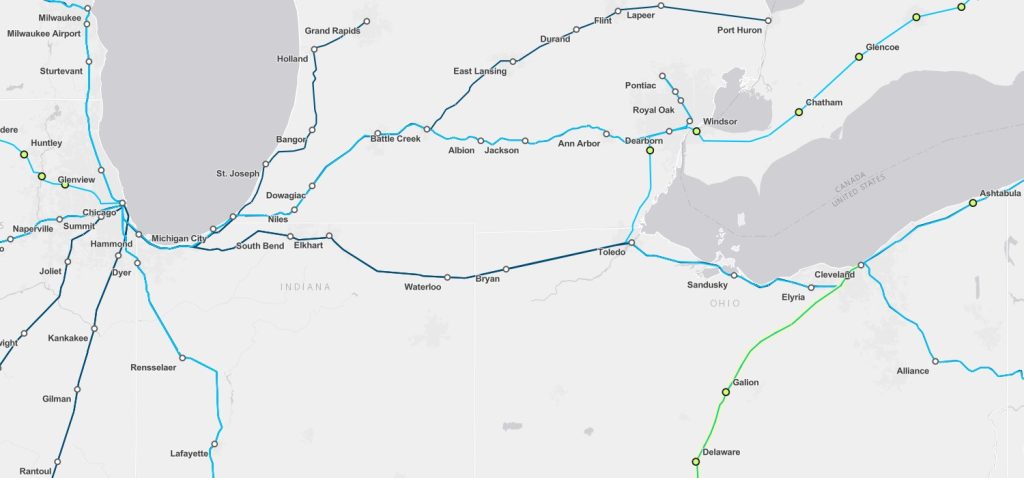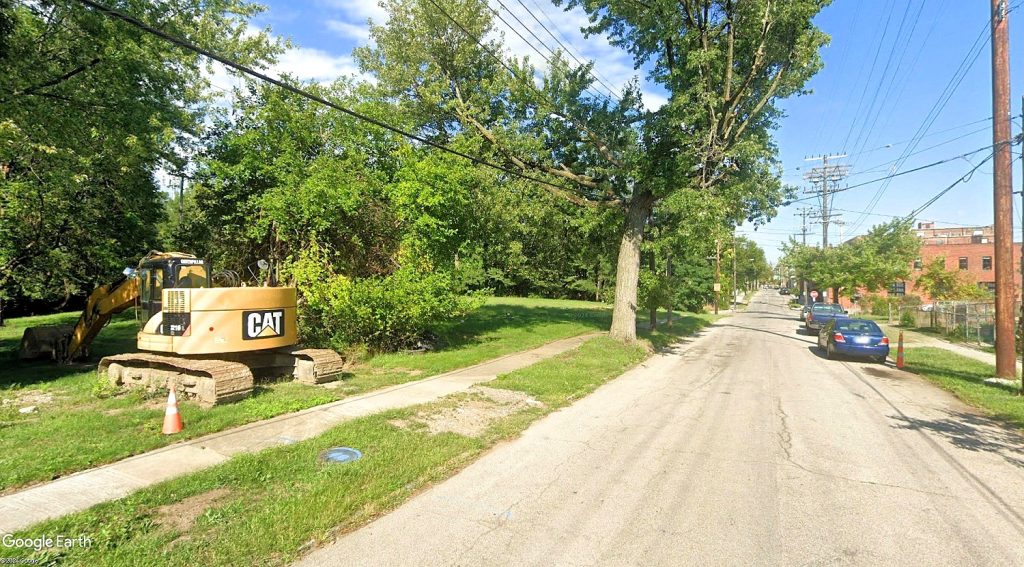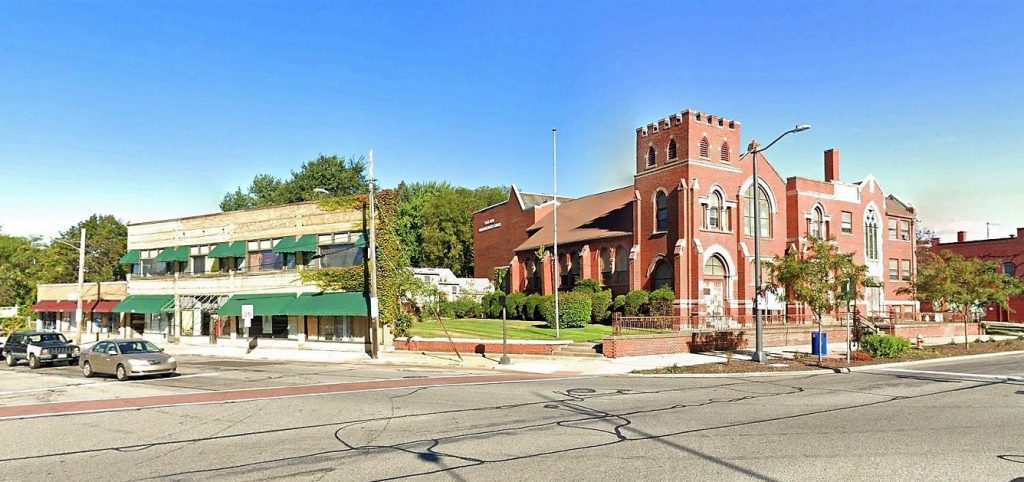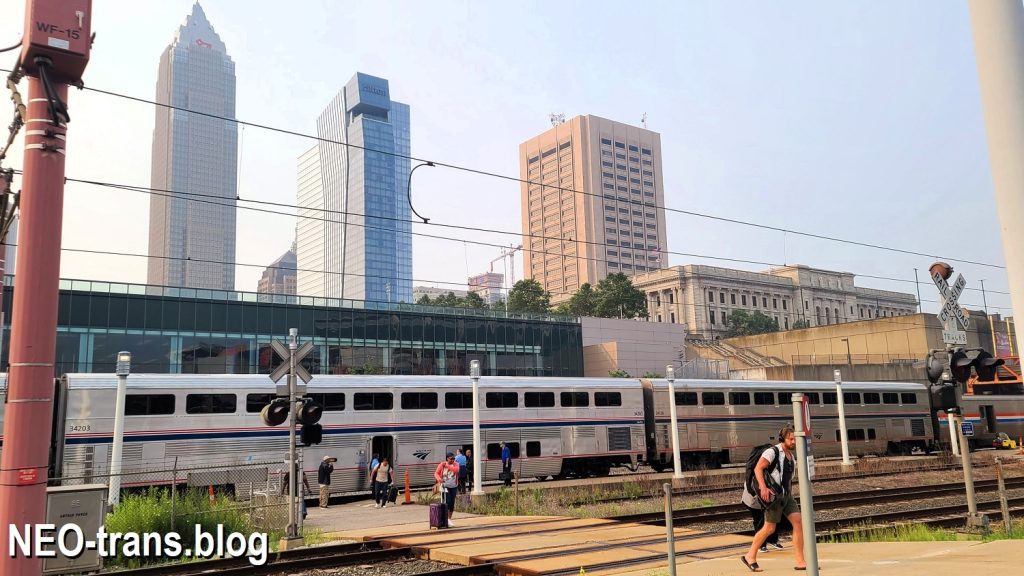
Cleveland’s Amtrak station occasionally sees a daylight passenger train when one of its nightly Chicago-East Coast trains is tardy enough. When that happens, Clevelanders get to imagine what it might be like if had normal daytime train service like its counterparts in neighboring states and a station more befitting a major city (KJP). CLICK IMAGES TO ENLARGE THEM.
Cleveland ID’d as beneficiary of stations program
ARTICLE UPDATED MAY 3, 2024
Cleveland and other Northern Ohio cities would gain new, larger train stations from a program proposed by passenger railroad Amtrak to improve its intercity services here. The program, a five-year, $300 million Great Lakes Stations Improvement initiative, represents the first time in Amtrak’s 53-year history that it has pursued such an aggressive development effort for this region and specifically for the Cleveland-Chicago route.
In its fiscal year 2025 budget request to Congress, Amtrak spelled out a number of capital improvement programs it wants in order to improve service, safety and efficiency. Amtrak ridership is, so far in fiscal year 2024 (started Oct. 1, 2023), exceeding its record high achieved in pre-pandemic 2019. The capital improvements are part of its plan to double its ridership nationwide by the end of 2040.
To do that, Amtrak’s existing trains must become more reliable and faster. And they need to serve more comfortable stations that are better connected with local, regional and other intercity transportation providers like Greater Cleveland Regional Transit Authority (GCRTA) buses and trains, Greyhound, GoBus and Barons Bus. Amtrak says its Great Lakes Stations Improvement program can help accomplish all of those goals.
In the first year of the new program, Amtrak wants Congress to direct $25 million to it in order to support pre-construction activities — designs, environmental documentation and permitting. Over the full five-year program, Amtrak wants a total of $300 million from Congress to build/expand the stations it plans.
“The Great Lakes Stations Improvement initiative would support new or improved stations in communities along the southern coasts of the Great Lakes, with an initial emphasis on 10 communities in Pennsylvania, Ohio, and Indiana,” Amtrak said in its request to Congress. “The initiative could also be expanded to other states. Specific project types could include construction of new station buildings, including station relocations; reconstruction or addition of platforms; and various kinds of trackwork in and around the relevant stations.”
For Cleveland, Amtrak says it wants a “new station with additional tracks and platform space.” Although it doesn’t say where that station would be, the city of Cleveland’s lakefront planning work completed thus far shows a 150,000-square-foot multi-modal transit hub next to and replacing the existing Amtrak station. The site is just west of East 9th Street and north of City Hall, combining Amtrak and GCRTA buses and trains in a single facility.
“As we do this, we are not only improving mobility and expanding options for travelers, but also creating significant economic value; contributing to environmental sustainability; supporting the health of our communities; improving quality of life; and strengthening social ties amongst our diverse and growing population,” said Amtrak CEO Stephen Gardner in introducing the Great Lakes Stations Improvement and other programs.
“I have long supported robust funding for the Amtrak national network, and specifically for improvement of the passenger station in Sandusky,” said Congresswoman Marcy Kaptur (D-9) of Toledo. “These funding requests from Amtrak for funding for stations in Toledo, Bryan, Sandusky, and throughout the Great Lakes region show the urgency to improve the Northern Ohio rail corridor which is the spine of our regional economy.”
Ben Kamens, communications director for Kaptur, added that she has sought for years for an improvement program for Amtrak stations and more train services on the Cleveland-Toledo-Chicago and Cleveland-Toledo-Detroit routes.
“We’re not sure if it will actually get fully funded with the Republicans in control of the House,” Kamens told NEOtrans. “But we’re in touch with Amtrak and we think it makes sense to meet what we’re asking.”
News of Amtrak’s Great Lakes Stations Improvement initiative was hailed by Grace Gallucci, executive director & CEO of the Northeast Ohio Areawide Coordinating Agency (NOACA), a metropolitan planning organization which distributes federal funds to transportation and air quality projects. NOACA has been actively promoting an Amtrak Cleveland hub.
“We are very excited to hear of this request,” Gallucci told NEOtrans. “It is definitely a step in the right direction. Improving stations along the Great Lakes, particularly the Capitol Limited and the Lake Shore Limited routes, will significantly improve the passenger experience along the Chicago-Cleveland corridor. Envisioning a new station in downtown Cleveland aligns well with the lakefront plans.”
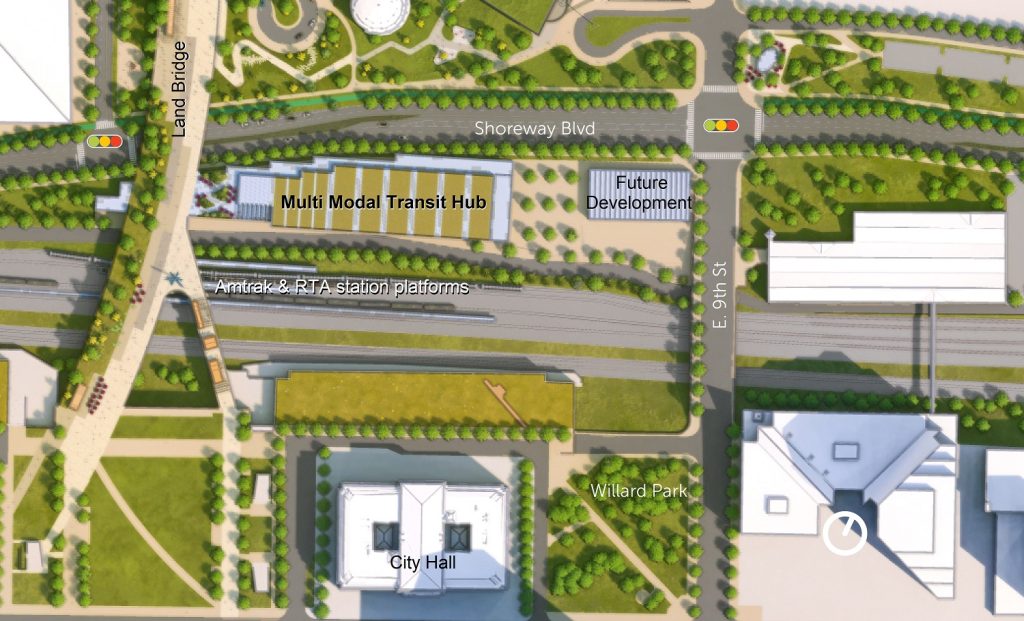
The city of Cleveland’s lakefront development masterplan released in October 2023 shows the proposed 150,000-square-foot multimodal transportation center where the current Amtrak station is located. It would combine two Waterfront Line rail transit stations and the Amtrak station into a single facility but, at this time, not include Greyhound or Barons Bus (FO).
Marie Zickefoose, the city of Cleveland’s press secretary, said NEOtrans’ inquiry was the first that Mayor Justin Bibb’s staff had heard of Amtrak’s station funding request. Thus, the administration was not prepared to comment except to say they’re “Looking forward to learning more.”
Cleveland’s Amtrak trains — two east and two west each night on the Chicago-Cleveland-Washington DC Capitol Limited route and the Chicago-Cleveland-New York City/Boston Lake Shore Limited route — carry about 600,000 riders per year. In total, those four trains transport the passenger equivalent of a dozen fully occupied, 135-seat Airbus A319neo airliners daily. Amtrak notes they could carry more people if they had the infrastructure for it.
Gallucci, who was previously deputy executive director at the Chicago Regional Transportation Authority, also welcomed Amtrak’s request for $250 million in federal funds for a Chicago Hub Improvement Program. That program will target multiple projects to reducing rail traffic congestion for Amtrak trains entering Chicago, especially from the east. She said that will address service issues along the entire Chicago-Cleveland corridor.
“We are thrilled with this initiative on the part of Amtrak and support it unequivocally,” said Bill Hutchison, a spokesman for the Lakeshore Rail Alliance, a coalition of organizations seeking more and better rail service between Chicago, Cleveland and New York City.
“This is a major first step toward creating modern rail passenger service to this part of the country,” he added. “It’s good to see Amtrak taking an interest in this route. The Chicago-New York route is one of the most densely populated routes in the country and connects the two biggest mega regions in the United States.”

In the mid-2010s, the city of Cleveland and other partners developed a plan for a multimodal transportation center on Downtown Cleveland’s lakefront. It was in response to finding Greyhound a new station when a developer showed interest in buying its old bus station. But when the developer grew impatient and lost interest, Mayor Frank Jackson’s administration lost interest in finding Greyhound a new station (WSP/AECOM).
Amtrak has urged the state of Ohio to sponsor an expansion of passenger rail services to Cleveland, called the Amtrak Connects Us plan. It could turn Cleveland into a mini- hub with nearly two dozen daily trains to and from places like Detroit, Columbus and Cincinnati. Departments of transportation in Ohio and Michigan have won federal Corridor Identification and Development (CID) Program funds to undertake service development plans for Amtrak expansion.
CID funds were awarded by the Federal Railroad Administration (FRA) to draft service development plans for the Cleveland-Columbus-Dayton-Cincinnati and Cleveland-Toledo-Detroit routes. The former shares the existing Cleveland-Toledo-Chicago Amtrak route for only about 10 miles west to Berea while the latter shares it for than 100 miles west to Toledo.
As part of its request to Congress for the Great Lakes Stations Improvement initiative, Amtrak explained that “Included (station) investments are not primarily intended to advance any proposals currently moving through FRA’s CID process; however, all are compatible with, and some would actually support, those efforts.”
The reason is that station improvements could increase the capacity of track-owning freight railroad Norfolk Southern to handle existing trains more efficiently at Cleveland station, as urged by rail and transit advocacy group All Aboard Ohio in 2016. And, station improvements west of Cleveland would allow the route’s existing freight and passenger trains to operate more reliably while also reducing travel times.
Amtrak wants to be able to serve stations along the south shores of the Great Lakes from either of the two parallel main tracks of Norfolk Southern’s Chicago Line. Currently, most station boarding platforms are only on one side of the railroad. Amtrak trains have to switch back and forth, or slalom between the two main tracks depending on which side of the main line the next station is located.
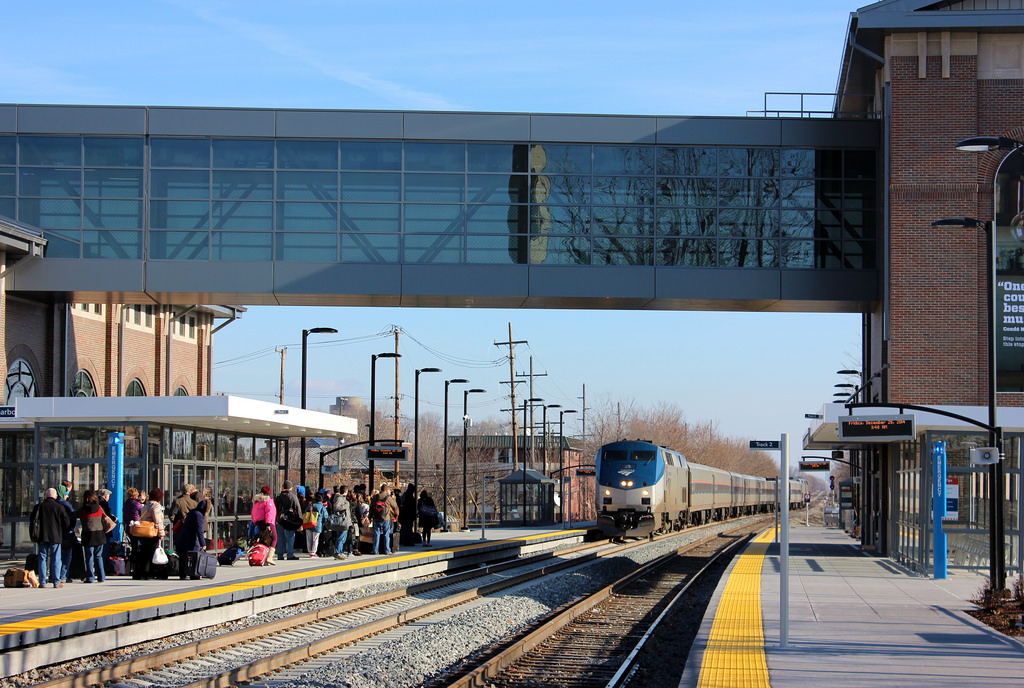
Dearborn, MI’s train station provides an example of what Amtrak would like to see at stations along the Cleveland-Chicago route. This station has boarding platforms next to both main tracks and are connected by a grade-separated walkway so travelers can safely get from platform to the other (Midwest High Speed Rail Association).
Also, some of the Amtrak stations’ trackside platforms like Elyria’s and Sandusky’s are too short for an entire passenger train up to 12 cars long to board/de-board passengers. So passenger trains often have to move forward a few cars to make two or even three stops at the same station.
According to a 2014 presentation by All Aboard Ohio, not only do these extra moves delay each Amtrak train by about five minutes per station, it also delays many of Norfolk Southern’s 70 daily freight trains using the same tracks. Addressing the 10 Amtrak stations from Erie, PA west to Chicago initially targeted by the program could result in saving 160 minutes each night in travel time just to Amtrak’s trains.
All Aboard Ohio and the Lakeshore Rail Alliance have asked, so far unsuccessfully, the city of Cleveland for an alternatives analysis to compare the costs of accommodating Amtrak’s proposed Amtrak Connects Us services at a lakefront station location amid the busy freight train traffic versus a restored station shared with Cuyahoga Valley Scenic Railroad at Tower City Center that would avoid interfering with freights.
The advocacy groups have successfully urged Amtrak to make repairs and cosmetic improvements to stations as well as to get Greyhound to move its bus stops to Amtrak stations in Toledo and Sandusky. It also got Greyhound to move to an historic railroad station in Downtown Elyria called the Lorain County Transportation Center that could see Amtrak move to it from a glorified bus shelter on the east side of town.
At Cleveland, Greyhound and Barons Bus services are in discussions about moving from the 76-year-old downtown bus station on Chester Avenue to the Stephanie Tubbs Jones Transit Center near the Wolstein Center arena. But some have suggested that the long-term solution is for Greyhound and Barons Bus to relocate their Cleveland stops into the new station that city, GCRTA and Amtrak officials are planning.
END

